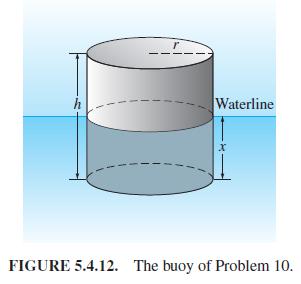Consider a floating cylindrical buoy with radius r, height h, and uniform density 0.5 (recall
Question:
Consider a floating cylindrical buoy with radius r, height h, and uniform density ρ ≦ 0.5 (recall that the density of water is 1 g/cm3). The buoy is initially suspended at rest with its bottom at the top surface of the water and is released at time t = 0. Thereafter it is acted on by two forces: a downward gravitational force equal to its weight mg = ρπr2hg and (by Archimedes' principle of buoyancy) an upward force equal to the weight πr2xg of water displaced, where x = x (t) is the depth of the bot- tom of the buoy beneath the surface at time t (Fig. 5.4.12). Assume that friction is negligible. Conclude that the buoy undergoes simple harmonic motion around its equilibrium position xe = ρh with period p = 2π√ρh/g. Compute p and the amplitude of the motion if ρ = 0.5 g/cm3, h = 200 cm, and g = 980 cm/s2.

Step by Step Answer:

Differential Equations And Linear Algebra
ISBN: 9780134497181
4th Edition
Authors: C. Edwards, David Penney, David Calvis





